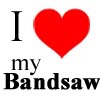I am refurbishing a contractor saw and building a table saw extension table for the uber long Vega Pro 50" fence I have picked up. Given the size of this puppy I want to include my router in this development project. I am replacing the left and right extensions. The right extension will be 27" x 54"(it rips to 50") and I am undecided on the left but it will likely be 27" x 24" (or 36").
My question has to do with where to mount the router plate. I plan to use the table saw fence as the back bone for the separate and removable router fence that will mount to it.
It makes sense to me to mount it on the left of the blade, on the shorter end of this mobile aircraft carrier. It is closer to the business end of things. But I can mount it anywhere I like really. I don't have a rationale and would appreciate any advice.





 Reply With Quote
Reply With Quote


 . I made a second stand alone router table fence that uses the T.S. fence front rail and a second clamp on the rear. That way I can use the router and still rip up to about 12" wide without moving the router table fence. If I had a wider table to the right I'd be able to rip wider. Bear in mind that a router table fence doesn't require being parallel with anything like a T.S. fence does. It only has to be straight, have movable faces to be able to adjust for different size bits and have dust collection(for me at least).
. I made a second stand alone router table fence that uses the T.S. fence front rail and a second clamp on the rear. That way I can use the router and still rip up to about 12" wide without moving the router table fence. If I had a wider table to the right I'd be able to rip wider. Bear in mind that a router table fence doesn't require being parallel with anything like a T.S. fence does. It only has to be straight, have movable faces to be able to adjust for different size bits and have dust collection(for me at least).




